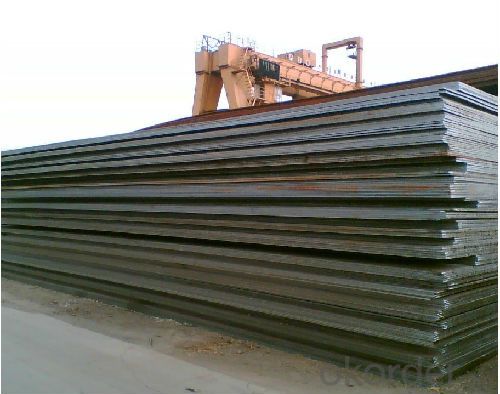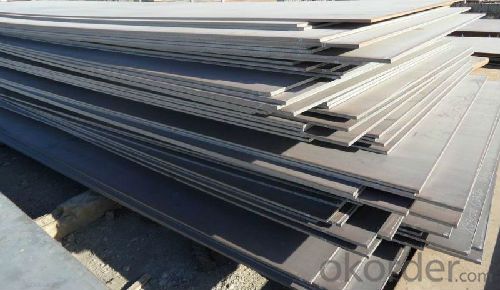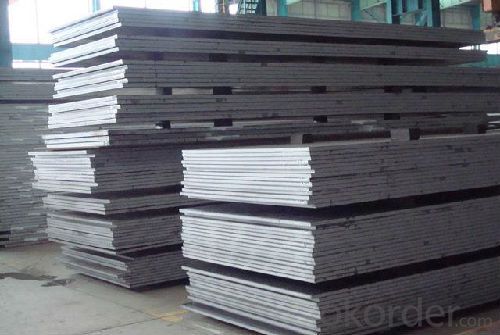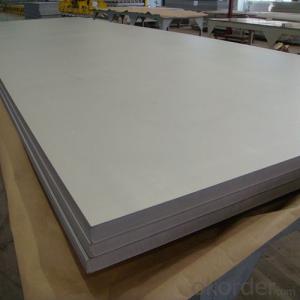Carbon Steel Plate China Made Structural Steel Plate
- Loading Port:
- Tianjin
- Payment Terms:
- TT or LC
- Min Order Qty:
- 100 m.t.
- Supply Capability:
- 50000 m.t./month
OKorder Service Pledge
OKorder Financial Service
You Might Also Like
Product Description:
OKorder is offeringCarbon Steel Plate China Made Structural Steel Plate at great prices with worldwide shipping. Our supplier is a world-class manufacturer of steel, with our products utilized the world over. OKorder annually supplies products to European, North American and Asian markets. We provide quotations within 24 hours of receiving an inquiry and guarantee competitive prices.
Product Applications:
Carbon Steel Plate China Made Structural Steel Plate are ideal for structural applications and are widely used in the construction of buildings and bridges, and the manufacturing, petrochemical, and transportation industries.
Product Advantages:
OKorder's Carbon Steel Plate China Made Structural Steel Plate are durable, strong, and resist corrosion.
Main Product Features:
· Premium quality
· Prompt delivery & seaworthy packing (30 days after receiving deposit)
· Corrosion resistance
· Can be recycled and reused
· Mill test certification
· Professional Service
· Competitive pricing
Product Specifications:
Standard:AISI, ASTM, DIN, GB, JIS
Grade:Q195,Q235,SS400,A36,Q345B
Thickness:1.5mm-200mm
Place of Origin:Tianjin, China (Mainland)
Brand Name:Zhenxiang-steel plate
Model Number:1.5mm-200mm steel plate
Type:Steel Plate
Technique:Hot Rolled
Application:Ship Plate
Special Use:High-strength Steel Plate
Width:600mm-3200mm
Length:any length
Standard:AISI, ASTM, BS, DIN, GB, JIS
Grade:Q195,Q235,SS400,A36,Q345B
Technique:Hot Rolled
MOQ:100 tons
Delivery Detail:25 days after receive payment
| Packaging Details: | steel plate suitable for exported packing in coil coil weight arround 2 mt |
|---|---|
| Delivery Detail: | 10-25 days after receive payment |
Steel Plate
1.Dimension:8-100
2.Length:1000-12000
3.Grade:Q235,SS400,A36,Q345
4.Large stock, low price, high quality
FAQ:
Q1: Why buy Materials & Equipment from OKorder.com?
A1: All products offered byOKorder.com are carefully selected from China's most reliable manufacturing enterprises. Through its ISO certifications, OKorder.com adheres to the highest standards and a commitment to supply chain safety and customer satisfaction.
Q2: How do we guarantee the quality of our products?
A2: We have established an advanced quality management system which conducts strict quality tests at every step, from raw materials to the final product. At the same time, we provide extensive follow-up service assurances as required.
Q3: How soon can we receive the product after purchase?
A3: Within three days of placing an order, we will begin production. The specific shipping date is dependent upon international and government factors, but is typically 7 to 10 workdays.
Q4: What makes stainless steel stainless?
A4: Stainless steel must contain at least 10.5 % chromium. It is this element that reacts with the oxygen in the air to form a complex chrome-oxide surface layer that is invisible but strong enough to prevent further oxygen from "staining" (rusting) the surface. Higher levels of chromium and the addition of other alloying elements such as nickel and molybdenum enhance this surface layer and improve the corrosion resistance of the stainless material.
Q5: Can stainless steel rust?
A5: Stainless does not "rust" as you think of regular steel rusting with a red oxide on the surface that flakes off. If you see red rust it is probably due to some iron particles that have contaminated the surface of the stainless steel and it is these iron particles that are rusting. Look at the source of the rusting and see if you can remove it from the surface.
Images:



- Q:Are steel sheets suitable for railway infrastructure?
- Yes, steel sheets are suitable for railway infrastructure due to their high strength, durability, and resistance to wear and tear. Steel sheets are often used for railway track components such as rails, sleepers, and bridges, as they can withstand heavy loads and provide stability to the railway system. Additionally, steel sheets can be easily fabricated and maintained, making them an ideal choice for railway construction projects.
- Q:Can steel sheets be used for food-grade applications?
- When using steel sheets for food-grade purposes, it is crucial to verify that they meet specific criteria. The food industry commonly employs stainless steel sheets due to their resistance to corrosion, durability, and ability to withstand high temperatures. Additionally, they are easy to clean and maintain, making them well-suited for food processing, storage, and transportation. For steel sheets to be deemed food-grade, they must exhibit a high level of purity and be free from any contaminants that may potentially leach into the food. Moreover, the steel should possess corrosion resistance, as any rust or corrosion can contaminate the food and present health risks. Alongside the material composition, the surface finish of the steel sheets plays a significant role in food-grade applications. Smooth and polished surfaces are preferred as they facilitate easier cleaning and prevent the accumulation of bacteria and other microorganisms. It is imperative to choose steel sheets that adhere to industry standards and regulations, such as those established by the Food and Drug Administration (FDA) in the United States or similar organizations in other countries. These standards guarantee that the steel sheets meet the necessary requirements for food safety. In summary, steel sheets can be utilized for food-grade purposes; however, it is vital to carefully select the appropriate type of stainless steel with the correct composition, surface finish, and compliance with relevant regulations to ensure the safety and quality of the processed or stored food.
- Q:What is the difference between a perforated and non-perforated steel sheet?
- A perforated steel sheet is a type of sheet metal that has small holes or perforations evenly spaced throughout the surface. These holes serve various purposes such as allowing for better airflow, drainage, or filtration. On the other hand, a non-perforated steel sheet does not have any holes and has a solid surface throughout. The main difference between the two is the presence or absence of these perforations, which determines their specific functions and applications.
- Q:Can the steel sheets be easily formed into cylinders or tubes?
- Yes, steel sheets can be easily formed into cylinders or tubes using various metalworking techniques such as rolling, welding, and bending.
- Q:What are steel sheets?
- Steel sheets are flat, thin metal plates made from steel that are commonly used in construction, manufacturing, and various other industries. They are versatile and durable, offering strength and resistance to corrosion, making them suitable for a wide range of applications.
- Q:How are steel sheets priced?
- Steel sheets are typically priced based on factors such as the grade of steel, thickness, size, quantity, market demand, and prevailing market conditions.
- Q:What are the different sizes of steel sheets available?
- Steel sheets are available in a wide range of sizes, catering to various applications and industries. The sizes of steel sheets can vary depending on factors such as thickness, width, and length. In terms of thickness, steel sheets are commonly available in gauges ranging from 7 to 30. The higher the gauge number, the thinner the sheet. Thinner sheets, such as those with a gauge of 30, are often used for applications that require flexibility, while thicker sheets, such as those with a gauge of 7, are typically used for heavy-duty applications that require high strength and durability. When it comes to width, steel sheets are available in a range of options. The most common widths include 36 inches, 48 inches, and 60 inches. However, customized widths can be obtained for specific requirements. Regarding length, steel sheets are typically available in standard lengths of 96 inches and 120 inches. These lengths are commonly used in various industries. However, like width, the length can also be customized to fit specific needs. It is important to note that the availability of different sizes of steel sheets may vary depending on the supplier and the specific grade of steel being used. It is advisable to consult with a steel sheet supplier or manufacturer to determine the exact sizes available for a particular application.
- Q:What are the different types of steel sheet finishes?
- Various purposes are served by several different types of steel sheet finishes, each providing unique aesthetics. Some common types include: 1. Hot Rolled: Achieved by heating the steel sheet above its recrystallization temperature and rolling it to the desired thickness. It has a rough and textured surface, suitable for applications where appearance is not a priority. 2. Cold Rolled: After hot rolling, the steel sheet is passed through rollers at room temperature to achieve a smooth and polished finish. Cold rolled finishes are often used in applications that require a superior surface finish, such as automotive panels or appliances. 3. Galvanized: In this process, the steel sheet is coated with a layer of zinc to provide corrosion resistance. The zinc coating also gives the sheet a shiny and reflective appearance. Galvanized finishes are commonly used in outdoor applications to protect against rust and harsh weather conditions. 4. Stainless Steel: Achieved by adding chromium to the steel sheet, providing excellent corrosion resistance and a sleek, reflective surface. Stainless steel finishes are widely used in kitchen appliances, architectural applications, and medical equipment, where hygiene and durability are essential. 5. Coated Finishes: Steel sheets can be coated with various materials, like paint, epoxy, or polymer, to enhance appearance or provide additional protection. Coated finishes can be customized to meet specific requirements, such as color or texture, and are often used in architectural and decorative applications. 6. Brushed: Obtained by brushing the steel sheet with abrasive material, creating a textured and matte surface. Brushed finishes are commonly used in interior design and furniture manufacturing, where a contemporary and stylish appearance is desired. These examples represent just a few of the available steel sheet finishes. The choice of finish depends on the specific requirements of the application, such as corrosion resistance, aesthetic appeal, or surface texture.
- Q:Can steel sheets be used for decorative wall panels?
- Yes, steel sheets can be used for decorative wall panels. They can add a modern and industrial touch to interior spaces.
- Q:Can 16Mn steel plate be used instead of Q345D steel plate?
- If the use of Q345D instead of using 16Mn, that can be, but 16Mn instead of Q345D can not, and also can not buy 16Mn steel now, that is the old number, and the latest brand is Q345A
1. Manufacturer Overview |
|
|---|---|
| Location | |
| Year Established | |
| Annual Output Value | |
| Main Markets | |
| Company Certifications | |
2. Manufacturer Certificates |
|
|---|---|
| a) Certification Name | |
| Range | |
| Reference | |
| Validity Period | |
3. Manufacturer Capability |
|
|---|---|
| a)Trade Capacity | |
| Nearest Port | |
| Export Percentage | |
| No.of Employees in Trade Department | |
| Language Spoken: | |
| b)Factory Information | |
| Factory Size: | |
| No. of Production Lines | |
| Contract Manufacturing | |
| Product Price Range | |
Send your message to us
Carbon Steel Plate China Made Structural Steel Plate
- Loading Port:
- Tianjin
- Payment Terms:
- TT or LC
- Min Order Qty:
- 100 m.t.
- Supply Capability:
- 50000 m.t./month
OKorder Service Pledge
OKorder Financial Service
Similar products
New products
Hot products
Hot Searches
Related keywords






























